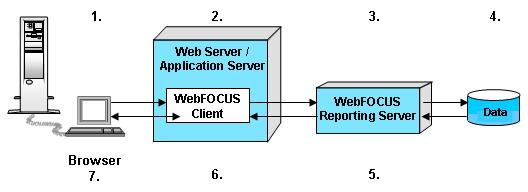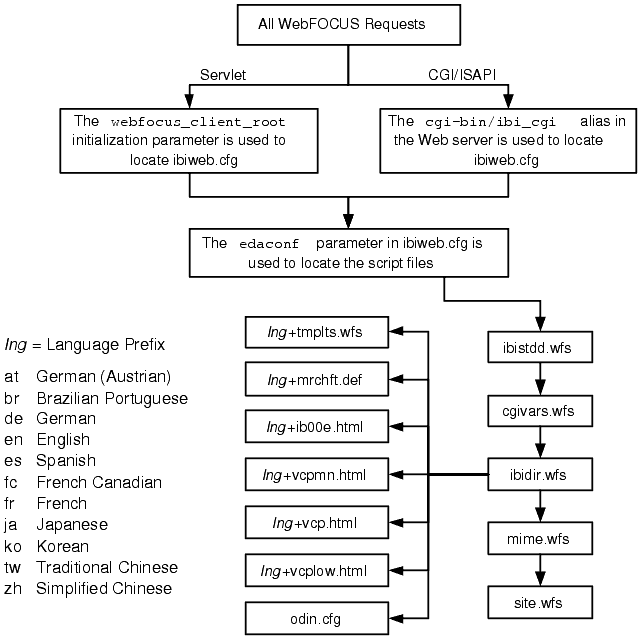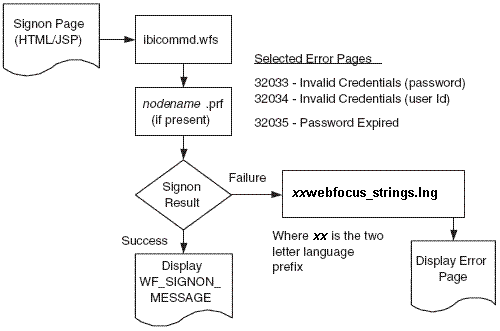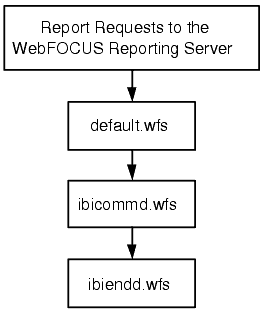Core Processing of WebFOCUS Requests
Core processing starts with context initialization for
all WebFOCUS requests. After context initialization, processing
depends on the type of request.
xOverview of How WebFOCUS Processes Requests
The following steps and illustration describe how WebFOCUS
processes requests.

- A user requests
a report from the browser and passes parameters by calling WebFOCUS
through links and forms on a Web page.
- The request
and parameters are handled by different components depending on the
WebFOCUS Client option in effect:
- If the WebFOCUS
Client option is ISAPI or CGI, the request and parameters are sent
to the appropriate program on the Web server, which processes the
parameters and creates a request for the WebFOCUS Reporting Server.
- If the WebFOCUS
Client option is servlet, the request and parameters are sent to
the WFServlet in the WebFOCUS Web application on the Java application server.
- The WebFOCUS
Reporting Server receives the request, processes it, and selects an
adapter to access the data.
- Data is retrieved
from data sources to process the request.
- The WebFOCUS
Reporting Server processes the request of the user using the retrieved
data.
- The response
is returned to the WebFOCUS Client.
- The response
is returned to the user.
xContext Initialization for All WebFOCUS Requests
To initialize the environment, WebFOCUS reads its configuration
and script files and loads variable-value pairs into the WebFOCUS
variable table. WebFOCUS does this initialization process for all
WebFOCUS requests.
First, the WebFOCUS Client must locate the configuration and
script files. To find the configuration and script files, the WebFOCUS
Client locates ibiweb.cfg file. The location of the ibiweb.cfg file
is found in the /WEBFOCUS/client/wfc/web/cgi directory.
Variables that control processing options are read from the WebFOCUS
Script (WFS) files. For a list of script files and their functions,
see WebFOCUS Client Configuration Files for Core Processing. Depending on the
type of request, files are processed in a specific order.

Some of the major WFS processing files are:
- ibistdd.wfs,
which is the master script file. It includes each of the other script files.
The
ibistdd.wfs file conditionally includes another script file named
mrsso.wfs. WebFOCUS creates the mrsso.wfs file when you configure
certain Managed Reporting authentication settings in the WebFOCUS
Administration Console. For more information about configuring external
authentication, see Configuring Managed Reporting for Trusted or External Authentication.
- ibidir.wfs,
which invokes the appropriate set of HTML files for the language
chosen in the GUI interface. The HTML files render error messages
and the on demand paging environment for each supported language.
The
ibidir.wfs file also invokes the odin.cfg file, which is used by
the communications layer to establish connections to available WebFOCUS
Reporting Servers.
For information about setting core processing variables using
the WebFOCUS Administration Console, see WebFOCUS Client Administration.
xCore Processing of a Sign-On Request
The WebFOCUS Client recognizes a WebFOCUS Reporting
Server sign-on request by the fact that it contains the following
parameter
IBIWF_action=WF_SIGNON
Generally, this is a hidden variable set in an HTML page that
prompts for WebFOCUS Reporting Server credentials. A sample sign-on
page, wfsignon.html, is supplied with WebFOCUS in the /WEBFOCUS/ibi_html
directory.
The sign-on command (IBIWF_action=WF_SIGNON) can also be embedded
in a jsp page that transparently redirects control to a WebFOCUS
application using WebFOCUS Reporting Server credentials obtained
from another page. For example, if you have a third-party package
that obtains and passes credentials to WebFOCUS, the WebFOCUS logon
page is not displayed.
If the WF_SIGNON action is successful, WebFOCUS uses the value
of the WF_SIGNON_MESSAGE variable to determine which page to display
next in the browser.
If the WF_SIGNON action is not successful, the connection fails
and the WebFOCUS Reporting Server provides a return code. This return
code is mapped to an error page in the xxwebfocus_strings.lng
template file, where xx is the two-letter language prefix.
For example, the return codes for invalid password and invalid user
ID are both mapped to a page with the message Invalid Credentials.
For more information on customizing messages, see Localizing WebFOCUS
.
The following diagram illustrates the client files processed
during a sign-on request.

xCore Processing of a Report Request
WebFOCUS executes a report request when the following
variables are present on the query string:
|
Variable
|
Description
|
|---|
IBIF_adhocfex |
Used to submit an inline WebFOCUS request
to the WebFOCUS Reporting Server.
|
IBIF_ex |
Used to execute a report procedure stored
on the file system of the WebFOCUS Reporting Server.
Note: IBIF_focexec
is a synonym for IBIF_ex.
|
The following diagram shows the WebFOCUS Client files that are
called to execute a report request. The default.wfs file includes
ibicommd.wfs in order to get the location of the CGI/Servlet. Then
default.wfs continues to prepare the environment for executing the request,
depending on which special options are selected, such as server
side graphics, Resource Analyzer/Governor, or data filtering with
DBA.




